If you were to look inside your Google Analytics right now, chances are that a majority of the traffic on your blog comes from 2–5 blog posts.
To confirm this, you can set up events in Google Analytics, which will let you measure product or service conversions that come directly from content.
What’s interesting, though, is that often the posts with the highest volume of traffic don’t have the highest volume of conversions.
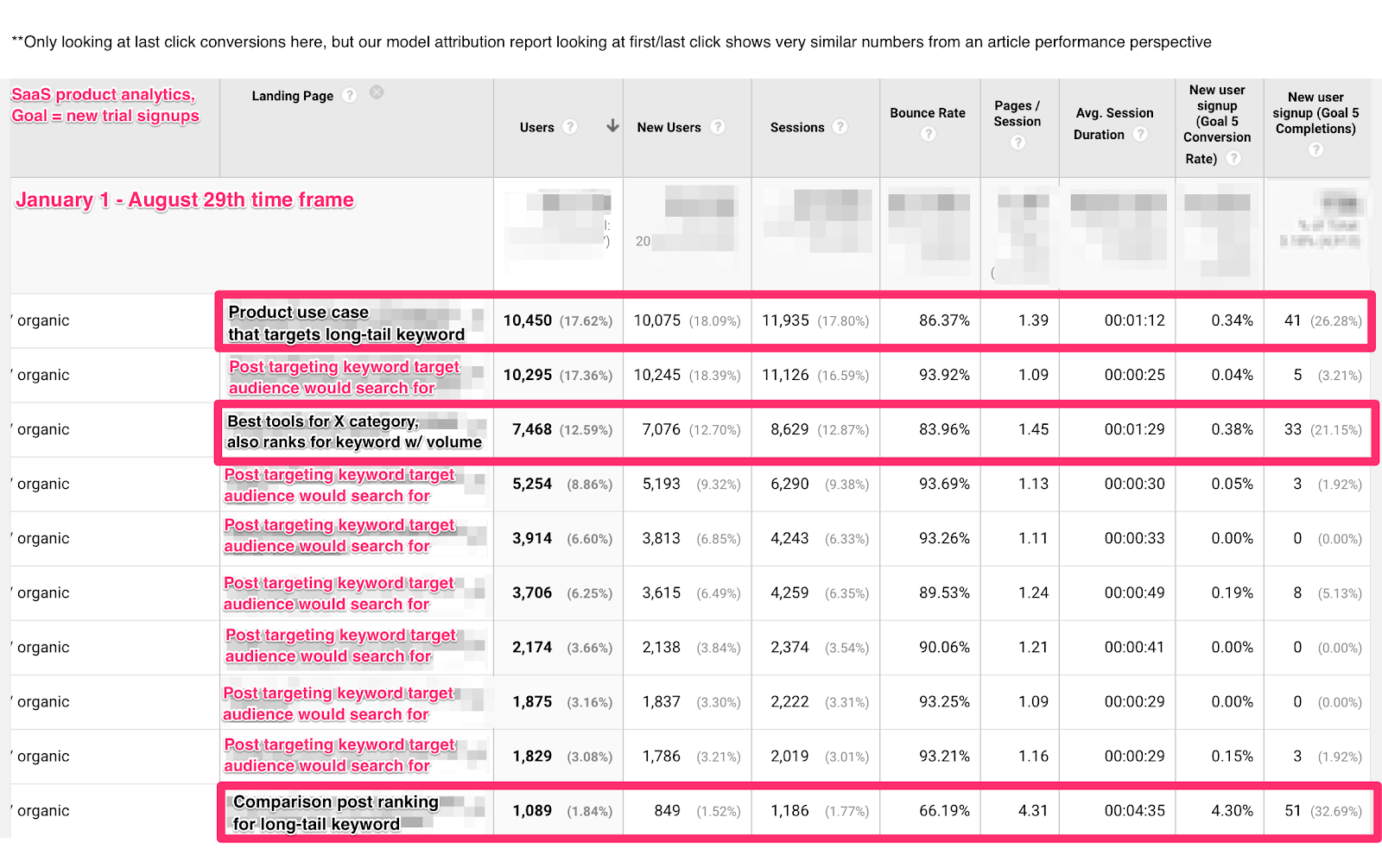
So what’s the disconnect?
It’s that head terms (or high volume queries) are typically terms that target the top of funnel for your product or service — they have more people searching for them, but less of the searches have buying intent.
In contrast, terms that target the middle or bottom of the funnel usually have fewer people searching for them but higher buying intent.
There are cases where you can go after keywords that have both high volume and have buying intent. If you can find those, they are obviously ideal, but typically there aren’t too many of these.
While many companies are focused on ranking for high-volume keywords in their content marketing and SEO efforts because of the traffic potential, we prioritize lower-volume, high-buying-intent keywords because the conversion potential is much greater than going after high volume keywords.

You can see that the non-highlighted (top of funnel) posts in that screenshot are converting between 0.03% and 0.19% and many of them haven’t even generated a single conversion in months (this is extremely common!). In contrast, the three highlighted bottom of funnel posts are converting at 0.3%, 0.4% or the last one a whopping 4.3% (also common for bottom of funnel, Pain Point SEO posts).
Building on that screenshot here is the 16th highest traffic article in a particular time period for another client, which brought in only 1,612 pageviews, but an amazing 39 product signups.

In addition to their much higher conversion rates, the lower-volume, high-intent keywords are often easier to rank for since most of your competition is focused on the high-volume lower converting keywords.
In this post, I’m going to explain how we come up with pain point driven content ideas for SEO that generate leads and signups instead of just going after high volume keywords. I’ll share some examples of frameworks that tend to do well from a conversion perspective and I’ll share some examples from blogs that we run that show why we take this approach vs. the approach that most agencies and content marketers take.
Curious about having us do content marketing for your business? You can learn more here. If you’d like to learn how to implement pain point SEO for your business, we also teach our content marketing process in our course and community.
What is Pain Point SEO?
Pain Point SEO is a strategy that we coined describing how to prioritize content ideas around high-intent keywords over high-volume keywords with the goal of driving conversions.
Our Keyword Strategy = Pain Point Driven SEO Instead of Volume-Driven SEO
Let’s say that you’re doing content marketing for a SaaS company that targets salespeople as the customer (broad target audience, I know, but it’s just for the sake of the example).
Many marketers take a keyword-first approach to content marketing.
They research some keywords that they think salespeople would be interested in and end up coming up with a keyword list that looks something like this:
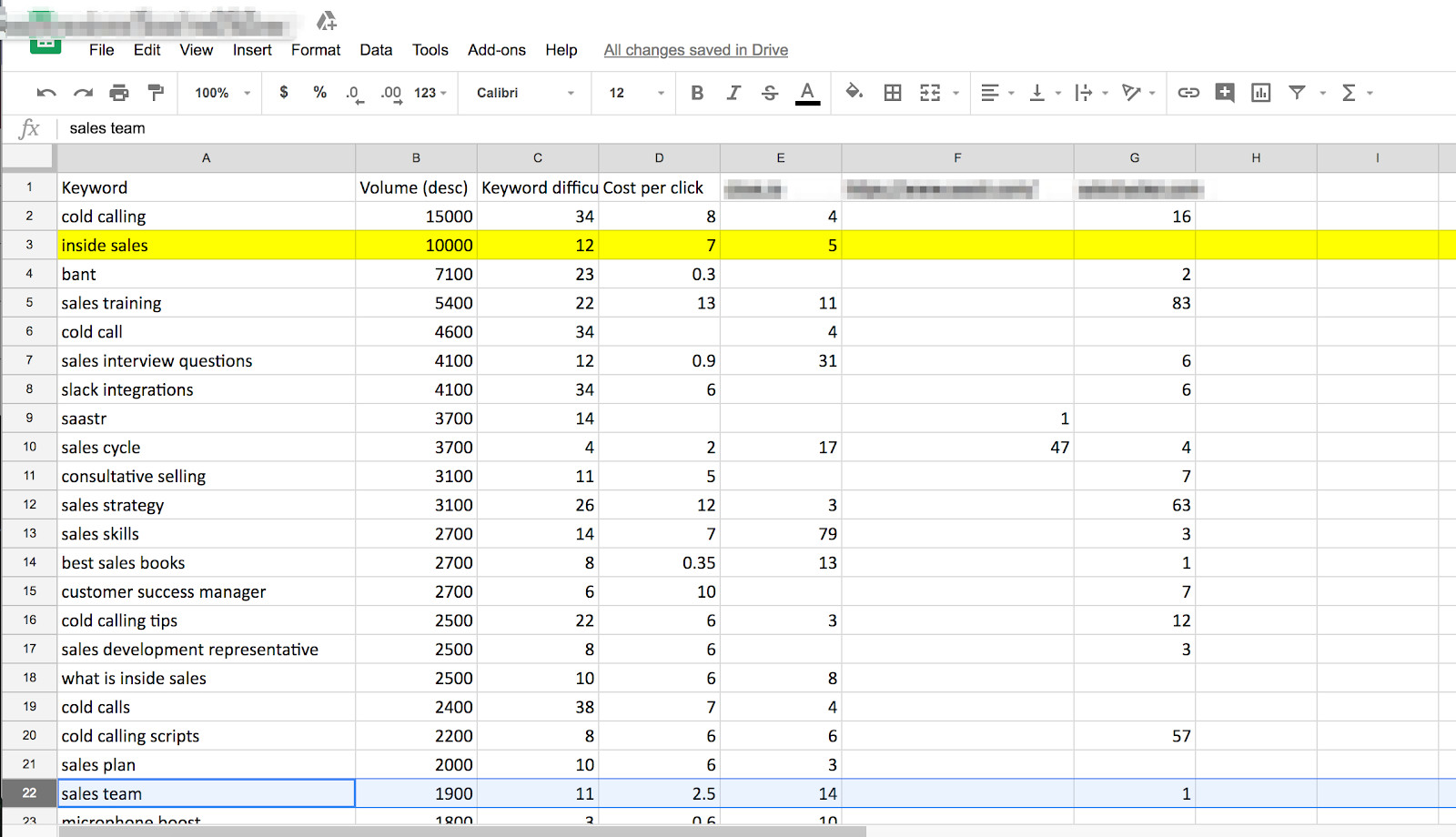
Then they prioritize what keywords to target based on which keywords have the highest volume (traffic potential) and which ones are easiest to rank for (low competition).
They do this because oftentimes their metric of success is a % increase in traffic, not leads/signups growth. The why behind this is a discussion for another post :).
Then blog posts start being produced that go after these high-volume keywords and if everything works you may notice that traffic starts to increase.
But what about the leads and signups from those posts?
Oftentimes, you don’t see a measurable amount of leads and signups coming from those blog posts topics because this strategy is designed to increase traffic, but doesn’t take the intent of the searcher into account.
We think this volume-based keywords strategy for content marketing is backwards.
Instead, the approach that we use to come up with SEO-driven content inverts the typical process. We start with the intent of a buyer (the pain point of a customer), then we find keywords and topics that discuss solutions to the problem the searcher is trying to solve.
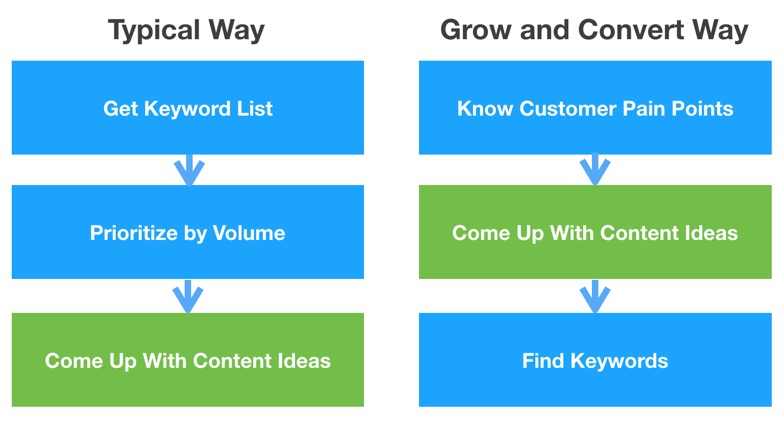
By taking a pain point first approach vs. a keyword-first approach, we can map the intent of the search to the buyer’s journey and have a better predictor of which SEO posts will generate leads and signups, instead of just measuring which posts will generate traffic.
Our Process for Coming up with SEO Topics That Drive Leads and Signups
Now that you understand the differences between going after high-volume keywords vs. pain point driven SEO, let’s dive into our exact process for ideating topics that generate leads.
The content frameworks we’ve found are the highest converting for SEO content
We’ve been applying Pain Point SEO to clients for years now (see case studies), and we’ve found it’s useful to think of Pain Point SEO in three tiers:
- Category Keywords: These are search terms that directly correspond to the product or service category you are in. For example: “best crm software”, “shopify development agency”, or “women’s hiking boots”. These are the most obvious keywords for your brand and are not hard to figure out – they’re just different ways to phrase what you sell. People searching these terms do not need to be led down any “buyer’s journey” or be made “problem aware” or anything of that sort. They’re already in the market for what you sell. It’s your job to show up for these searches and convince them your solution is worth trying. It’s borderline inexcusable not to very intentionally have pages on your site aimed to rank for these keywords, even if it’s your homepage. That said, you need to think of all of the variations that people could call your product or service, and some of the interview questions below can help. For us, some might call us an “SEO agency”, others might call us a “content marketing agency” or a “SaaS content marketing agency.” You should try and rank for all the synonyms of what people might call your category. You can find many examples of keywords like this in our case studies.
- Comparison and Alternatives: These are keywords that indicate the searcher is comparing your or your competitors’ products. They include terms like “salesforce vs hubspot”, “salesforce alternatives” and more. Like category keywords, people who search for these are indicating they are deep down the buying funnel and are ready to try or buy a product in your category. Many of them may be looking at switching from a competitive product or are comparing options to decide what to buy. As such they are also very high converting. When we first started going after these comparison keywords years ago, they weren’t as popular and therefore easier to rank for. Now, they have grown in popularity in the SEO community so some of these keywords have more competition but they are still, in our opinion, an under-utilized content type that most brands would benefit greatly from targeting. This case study includes several examples.
- Jobs-To-Be-Done Keywords: Finally we have the bulk of what Pain Point SEO will unveil for you, which are Jobs To Be Done (JTBD) keywords. This is a term we coined playing off of the popular JTBD framework that encompasses all the keywords that indicate the searcher has a problem your product or service solves without them explicitly searching for the solution like in frameworks #1 and #2 above. Continuing on the examples above these include how to queries like “how to manage sales leads”, “how to migrate from bigcommerce to shopify”, and more. For these keywords you should provide helpful advice but also present your product or service as a possible solution (often the best solution). This highlights the most essential trait of JTBD keywords: they still have buying intent despite not being as bottom of funnel as the first two frameworks. This is what separates JTBD keywords from top of funnel keywords that don’t lead to conversions: they have buying intent. We have an entire article about JTBD keywords.
It can be helpful to visualize the Pain Point SEO in the context of a marketing funnel:
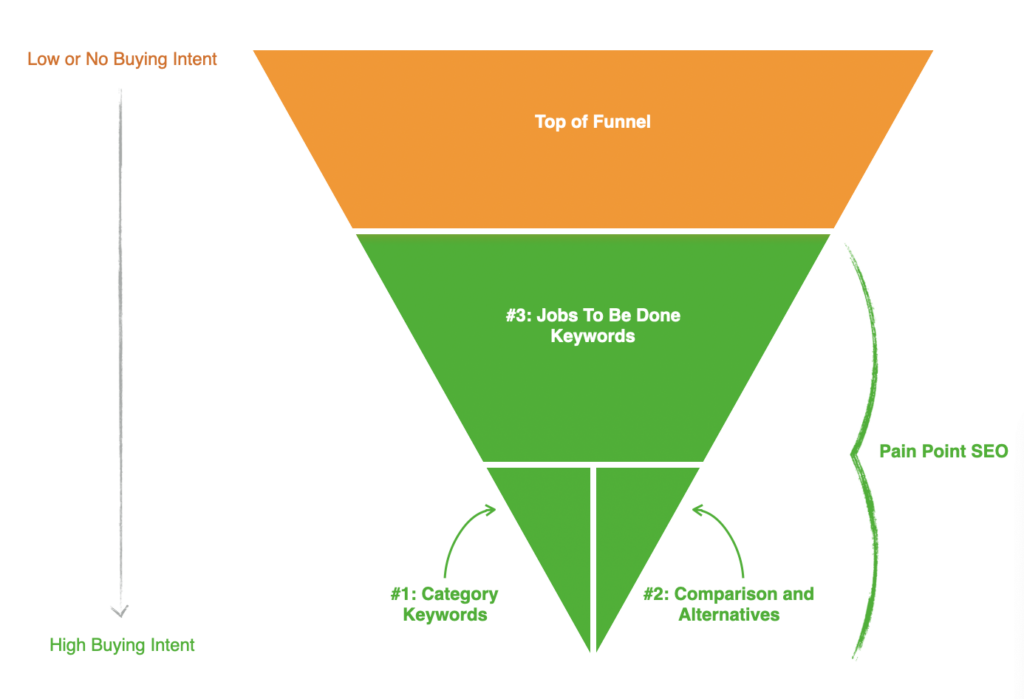
At the bottom of the funnel are frameworks #1 and #2, category and comparison keywords. It’s hard to say which are higher converting because we’ve seen keywords in both categories be extremely high converting for different clients, so we put them both equally in the “extreme bottom of funnel” camp.
But there is a limited set of these, indicated by them taking up less area in the triangle (although for some clients, we’ve spent years exclusively going after keywords just in these two frameworks).
Then, above that is the framework #3, JTBD keywords. You can consider these “mid-funnel” keywords (this is a subjective designation but can be helpful for understanding) since these are typically lower converting than frameworks #1 and #2. But these keywords still have buying intent because you can reasonably assume some fraction of searchers are open to the idea of using your product or service to solve their problem.
And finally, above these are top of funnel keywords, distinguished by a different color, which typically have very little buying intent. We rarely if ever produce these for clients. They’re good for building traffic but, based on our data, they barely convert (see analytics screenshot at the top of this article).
Note that this schematic is simply a helpful way to think about these keywords, it’s not meant to be taken literally. For example, although it shows sharp lines separating these categories, in reality, lines can be blurred and there are always keywords where it’s not clear if they are in bucket or the other. But that doesn’t matter. If you stick to finding keywords in these three buckets and prioritizing by buying-intent you’ll see great results from content and SEO.
We recently did an in-depth analysis of 95 blog posts to see how the conversion rates of each of these types of keywords compare. Check that out here.
Ideating on high-converting topics for SEO
Now that you know the frameworks that you should be thinking about, I want to share how you get the ideas that fit into the frameworks.
Essentially, all of the ideas should come from your prospects and your customers. If you’ve been a follower of our site for a long time, you’ll know our entire strategy starts with having a in-depth understanding of your customers. If you know your customers inside and out, you’ll be able to come up with content ideas that your competitors won’t target because they’ll be focused on traffic while you’ll be focused on helping your customers and future customers solve problems.
By knowing who your prospects/customers view as your competitors (#2), what problems your prospects/customers think your product or service solves (#3), what features or parts of your service your customers get the most value from (#1), how your customers describe your product or service and the value they get from it (#1, #3), you should be able to come up with plenty of these high converting content ideas.
Survey questions to ask to identify conversion focused SEO topics to write about
Below are some questions to ask your customers via in-person interviews, phone calls, and surveys to help you identify high intent keywords to target.
Note: a shortcut to talking directly with your customers is to talk to your sales team or other employees in customer facing roles and ask them variations of the same questions below. This is in fact what we do with all of our clients.
1. What was the problem you were looking to solve before stumbling across our product or service?
This question helps you identify what keywords to target when someone is researching for a solution to the problem that your product or service solves.
2. If our product/service were no longer to exist, what product/service would you use as an alternative?
This question helps you identify who your customers view as your competition.
3. How would you describe our product/service to a friend who knew nothing about us?
This question helps you identify how your customers would describe your product to a friend — maybe they describe what you do differently than you describe it — it’s important to figure this out so you can capture search volume for terms you might not be thinking of.
4. What are the top 3 benefits that you receive from our product/service?
This question helps you identify the top use cases and benefits that customers get from your product or service.
5. If you were to research our product or service, what would you search for?
This question helps you identify the terms that your customers would search for to find your product/service.
Once you have the answers to these questions, it’ll help you figure out the specific ideas to apply to each framework.
For example, if a majority of respondents say the biggest benefits they get from your product or service are increasing qualified leads to sales teams, increasing sales pipeline, and closing more deals, then you might want to create articles on those topics that walk people in-depth through various ways they can accomplish those things (your product or service might be one solution to their problem — you’ll need to include other valuable ones as well).
Another example, if a majority of respondents say that if your product was no longer to exist, they’d use Hubspot or Marketo, then you might want to create blog posts that compare your product to Hubspot and Marketo, and weigh the pros and cons of using your product vs. theres.
Hopefully you get how this works from here… (if not, feel free to leave a question/comment below)
Case Study: Going After Long-Tail High Intent Keywords Beats Out High-Volume Keywords
(Note: If you want to read more case studies beyond the example below, you can find them here.)
Now for some proof that this approach works.
Over the past year, we’ve been testing different frameworks across clients — narratives (stories), case studies, data posts, as well as the five frameworks above. Across multiple clients, we’ve seen these frameworks outperform some of the other content from a conversion perspective.
Because we started seeing these trends emerge, we thought we’d share the strategy with you.
The following analytics screenshot is from one of the SaaS companies we work with. This report is looking at organic traffic, the page that they landed on from organic search and the number of last-click conversions to that article.
To protect our client’s data, I’ve grayed out the URL of the article and in its place, I’ve put a description of the article.
All of the other numbers are left as is.

Now what’s important to note here is that not all organic traffic is created equal from a conversion perspective. If you look at blog post #1 and #2 here, you’ll notice that they get almost the identical level of traffic, but #2 gets far lower conversions.
This is because the blog post #2 ranks for a keyword the target audience would search for, in this case a sales related keyword, however, the post doesn’t follow one of our three Pain Point SEO frameworks, so it’s a classic low-converting top of funnel post.
What’s also important to note is that to help increase conversions for each of our blog posts, we use in-article CTAs that are contextual to the post.
For example, if we were to write a post about best CRM tools, the post would have a CTA that says something to the effect of “Looking for a CRM tool for your small business? Try a free trial of X tool for 30 days, free.”
Another thing to note is that, as mentioned at the beginning of this article, the highest converting blog post also has the lowest traffic, but that post uses one of the highest intent frameworks: comparing competitive products. When we originally did keyword research for this comparison term, multiple SEO tools showed zero search volume behind this particular long-tail keyword.
Let me repeat this point because it’s important: The post with the largest number of conversions in the screenshot below targeted a keyword that tools like Ahrefs and Moz showed as having zero search volume.
Most marketers would just move on and not write a post on this topic.
But while the traffic doesn’t compare to the rest of the posts on the list here, the post dwarfs most others from a conversion standpoint.
We have written more about targeting these “mini-volume keywords”, or you can see an additional example of how SEO tools grossly underestimate search volume in this Twitter thread:
Now, let’s look at GA’s model comparison tool to see the top converting blog posts that we’ve produced from January 1 – August 29th, to see which of the content frameworks yield the highest amount of new trial signups, when also factoring in first-click conversions.
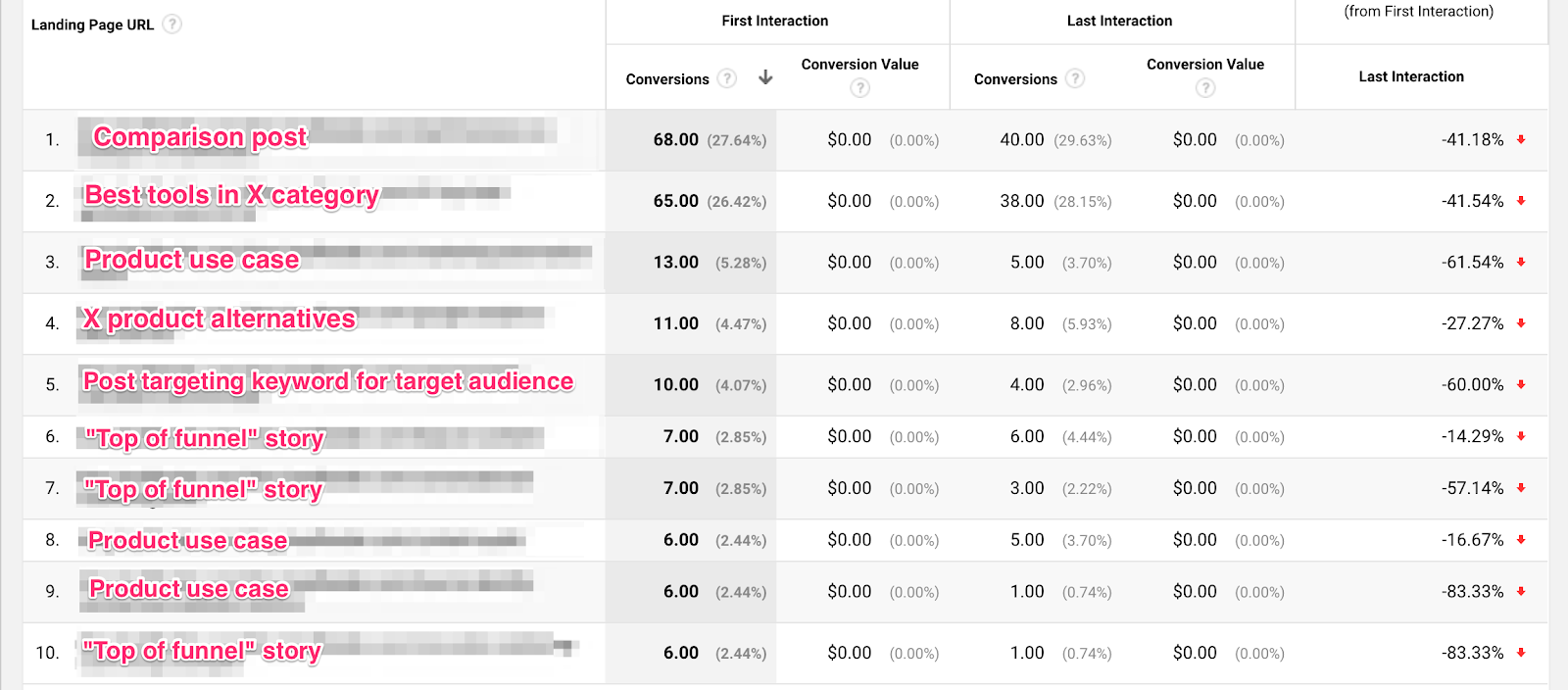
We can see here that the highest converting posts use the frameworks above. Only three of the top 10 posts are what we consider “top of funnel” articles and they make up only 10% of conversions.
That’s crazy. 90% of the conversions from these top 10 articles are from one of the 5 simple high-product-intent frameworks we listed above.
You can read a more exhaustive analysis of 60+ posts categorized as bottom of top of funnel, and their differences in traffic and conversion rate here.
What you should take away from this
We’re not saying that you have to only produce SEO content that falls within those three frameworks, but what we are saying is that we’ve noticed trends across multiple clients, that when you produce pain point driven content that use these three frameworks to target long-tail keywords, we’ve seen conversion numbers that are much higher than other content that ranks.
Therefore, we think you should prioritize producing those pieces of content before going after terms that are high volume / low competition in your category or that your target audience would potentially be interested in reading about.
Once you feel like you’ve exhausted all of the potential long-tail keywords using the five frameworks, then it makes sense to take a broader approach to finding higher volume keywords in your category and that your target audience would potentially read.
In addition, using this strategy effectively also depends on writing really good posts that fulfill the search intent of the searcher. If you want to learn more about this, we wrote detailed articles about our process for SEO content writing and SaaS content writing.
If you want further strategy articles on this topic, in addition to the case studies linked to above, we’ve also written detailed articles on SEO keyword strategy, SaaS SEO strategy, B2B content marketing strategy, and B2C content marketing strategy. You can find our full slate of strategy based articles here.
Finally, since we originally published this article, we have also applied similar conversion-focused principles to improving client’s paid search campaigns. We wrote about that extensively here.
Pain Point SEO Video Explainer:
We created this one hour video explaining what Pain point SEO is and some examples of how it’s implemented.
Interested in implementing the Pain Point SEO strategy for your business?
- Bonus Video – For our newsletter subscribers, Devesh recorded a 20 min screencast of him using Pain Point SEO to come up with better keywrods for the hypothetical sales related company discussed above. You can join our email list to get a link to that video.
- Our Agency – Have us implement our pain point SEO strategy and drive results for you here.
- Our Content Marketing Course – Individuals looking to learn pain point SEO and our entire content strategy, taught via case studies, learn more here or see this video walkthrough:
Questions / comments, feel free to add them in below and we’ll get back to you 🙂








